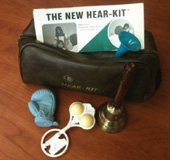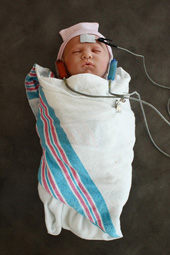Screening and Diagnosis
Newborn Hearing Screening
Newborn hearing screening is now conducted using physiologic measures (auditory brainstem responses or otoacoustic emissions). In 2009, over a 130,000 newborn infants were screened in North Carolina prior to hospital discharge. Permanent hearing loss in newborns occurs at a rate of 1-3 per 1000 in the well-baby population. The prevalence is approximately 10 times higher among infants whose birth history required special care in the neonatal intensive care unit. As a result of newborn hearing screening it is now possible to identify hearing loss and fit hearing aids within weeks of birth.
Most infants born with permanent hearing loss have enough residual hearing to benefit from amplified sound. When hearing loss is too severe to benefit from hearing aids, a cochlear implant can provide electrical stimulation to the auditory nerve.
Many young children who have had the benefit of early identification and intervention with hearing aids or a cochlear implant perform at or above age level when they enter school. Audiologists, working in collaboration with ENT surgeons, speech-language pathologists, deaf educators, and early intervention specialists, are making it possible for children born with permanent hearing loss to have the benefit of an early start in their auditory learning and development of spoken language.
-Jackson Roush, PhD, Professor and Director, Division of Speech and Hearing Sciences

Photo: Jack Roush

Photo: Robert Ladd
Infant screening equipment courtesy of Natus Corporation

Photo: Robert Ladd
Western Electric 6BP Portable Audiometer courtesy of Michael Touch
Audiometer
The audiometer is a device used to obtain hearing thresholds for pure tones. By comparing sound presented by air conduction (through an earphone) and bone conduction (from a bone vibrator) the audiologist is able to determine the type and degree of hearing loss. This Western Electric Model 6B from the 1930’s is one of the few still remaining.
In the 1930s, when this audiometer was in use, the tone at each of the frequencies marked on the dial at the left was first presented to the patient at a level definitely audible to him. He was instructed to keep his finger raised as long as he heard the tone, and to signal when the tone was no longer heard. The intensity of the tone was then gradually reduced by turning the dial at the right until the patient was just able to hear the tone. At this point the hearing loss was read in decibels directly from the dial at the right and recorded on the audiogram.


 Hearing Loss
Hearing Loss





